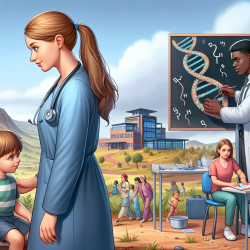Introduction
DiGeorge Syndrome, also known as 22q11.2 Deletion Syndrome, presents a myriad of diagnostic challenges, particularly in low-resource settings. The recent case study of a 38-year-old woman diagnosed with DiGeorge Syndrome highlights the complexities and implications of delayed diagnosis. For practitioners, understanding these challenges is crucial for improving diagnostic accuracy and patient outcomes, especially in diverse and resource-limited environments.
Understanding the Challenges
The case study underlines several key challenges in diagnosing DiGeorge Syndrome:
- Phenotypic Variability: The syndrome can affect multiple organ systems, including cardiac, endocrine, and skeletal systems, leading to a wide range of symptoms that vary significantly among individuals.
- Resource Limitations: In low-resource settings, access to genetic testing and specialist care is often limited, delaying diagnosis and treatment.
- Ethnic Variability: Phenotypic presentations can vary across different ethnic groups, complicating diagnosis in non-Caucasian populations.
Implications of a Missed Diagnosis
A missed or delayed diagnosis of DiGeorge Syndrome can have significant implications for the patient and their family:
- Health Risks: Patients may experience severe health issues, such as cardiac anomalies, immunodeficiency, and endocrine disorders, which require timely intervention.
- Family Impact: Genetic counseling and testing for family members are crucial, as there is a 50% chance of passing the deletion to offspring.
- Psychosocial Effects: Delayed diagnosis can lead to prolonged health complications and stress for both patients and their families.
Opportunities for Practitioners
Practitioners can play a pivotal role in improving outcomes for patients with DiGeorge Syndrome by:
- Increasing Awareness: Educating healthcare providers about the diverse presentations of DiGeorge Syndrome can enhance early recognition and diagnosis.
- Utilizing Technology: Facial analysis software and mobile diagnostic tools can aid in identifying phenotypic features in resource-limited settings.
- Promoting Genetic Testing: Encouraging genetic testing and counseling for at-risk families can prevent future complications and guide treatment plans.
Conclusion
DiGeorge Syndrome remains an underdiagnosed condition with significant implications for affected individuals and their families. By understanding the challenges and leveraging available resources, practitioners can improve diagnostic accuracy and patient outcomes. This case study serves as a reminder of the importance of vigilance and innovation in addressing complex genetic disorders.
To read the original research paper, please follow this link: DiGeorge Syndrome Diagnosed at Age 38: Challenges in Low-resource Settings and Implications of a Missed Diagnosis.










